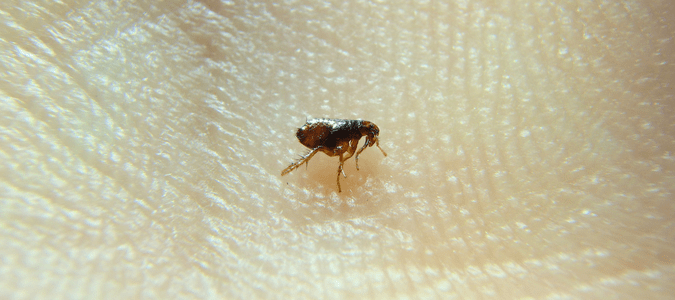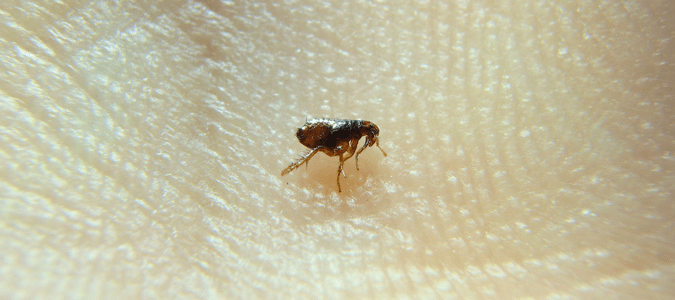If you think that you can only have fleas in your home if you have a dog or a cat, you aren’t alone. Flea infestations are more common if you have a dog or a cat. But, these parasites can make their way inside on any type of fabric. This includes any piece of clothing on your body or any item you may bring inside your house that has been in an infested area.
If you have grass in your front or back yard, these tiny parasites can hitch a ride with you or a guest into your home. Fleas could also enter your living spaces if you return from a friend’s house with a flea problem. Another possibility is that a wild animal with fleas, such as an opossum, feral cat, skunk or raccoon, may have taken up residence on your property. In these cases, these creatures may introduce fleas as they build a nest in your attic, in trees near your home or even underneath your patio. As a result, you could have a flea problem that needs the help of a pest control professional, even if you have no furry family members.
How Long Can Fleas Live Without A Host Animal?
The most common types of fleas are the cat flea (Ctenocephalides felis) and the dog flea (Ctenocephalides canis). There is a type of parasite called a human or house flea (Pulex irritans). They prefer to feed on the blood of the two-legged members of your household. However, they are quite uncommon in industrialized areas. Cat fleas are responsible for about 75% of home invasions. While cat and dog fleas prefer cats and dogs, these creatures will prey on humans for sustenance.
Fleas are very fast to reproduce. A female can lay as many as 1,000 eggs during her lifetime. Larvae can hatch from these eggs in as few as two days. The heat produced by pets and people, the carbon dioxide from our breath and the physical pressure as we and our pets walk on top of pupal cocoons can all encourage adult fleas to emerge from their pupal cocoons.
What this means is that the movement of the human members of your household can attract the attention of cat fleas. They would rather feast on the blood of Fido or Fluffy. It can also explain why flea infestations can occur after returning from a vacation or when moving into a new home. This is when adult fleas in their cocoons for extended periods of time notice a suitable host may be nearby. New adult fleas have adapted to move to higher locations on our furniture, window treatments, carpet and vegetation to find a blood meal. These are often close to living and recreational areas where humans can become targets for hungry fleas.
How Fleas Get Around
A flea’s eyes are drawn to objects that move against a light background, which could be us walking in front of a wall. While fleas don’t have wings, these parasites are expert jumpers. They can launch themselves up to a foot after sensing carbon dioxide and warmth that might indicate a passing host. Once firmly attached to a host, a cat flea begins to feed on the host animal’s blood. One flea typically feeds for eight hours a day or more. They can live on a host for three to four months. Most adult fleas can only survive for up to 10 days without locating a host. Some fleas have been known to live up to two years without feeding in low temperatures and high humidity.

Can Cat Fleas Live On Humans?
If fleas can live for years under some conditions without a blood meal, does that mean that fleas can live on our bodies? While humans can serve as a temporary host for cat fleas, cat fleas produce more viable eggs if they feed on the blood of a feline. Cat fleas don’t necessarily require a cat to survive. This parasite can also feed on the blood of dogs, opossums, foxes and rats.
To better understand and address a flea problem, it’s helpful to learn more about the flea life cycle. The length of a flea’s life cycle is influenced by temperature and moisture. Ideal conditions are around 85 degrees Fahrenheit and 85 percent humidity. Development is inhibited when sustained temperatures dip below 55 degrees Fahrenheit. The four stages are egg, larvae, pupae and adult flea. The female flea will start laying eggs just about two days after her first feeding. She will lay about 20 eggs at a time. She does have the ability to lay up to 50 eggs in one sitting. Eggs are tiny, oval-shaped and whitish. They are usually deposited on the skin or hair of a host. When a host moves, eggs can fall onto rugs, carpets and bedding. Eggs tend to be concentrated in resting areas, where hosts spend the majority of their time.
Cat Fleas as Larvae
Depending on the environmental conditions, eggs begin hatching, generally anywhere from two days to two weeks. Larvae will avoid sunlight, opting instead for moist, dark environments. During this time, flea larvae remain in cracks in the floor, bedding and carpet. This is where they feed on the feces of adult fleas. These waste products look like small reddish specks of dirt. This is often one of the first signs that you have fleas in your home.
Using debris found nearby, fully grown fleas spin a cocoon to provide camouflage as they enter the pupal stage. Under favorable conditions, the larva darkens into a brownish color and emerges in five to seven days. This period can last up to a year, however, if it’s colder or less humid. When adult fleas exit the pupal stage, they are up to an eighth of an inch long and are dark brownish-red to black in color. With back legs adapted to literally spring into action to find a host, fleas’ bodies are thin. Each day, an adult flea can consume as much as 15 times their body weight in blood. That’s why it’s important to reach out to a pest control professional at the first sign of fleas.
Now that we have established that cat fleas can’t live long without a feline host, you may ask yourself: what about dog fleas?

Can Dog Fleas Live On Humans?
Since cat flea infestations are far more common than problems with dog fleas, research and control efforts have been focused on these types of fleas. That said, dog fleas can’t live on humans, but they can live near us. If we accidentally bring fleas into our homes on a pant leg or our shoes, these parasites can fall onto our floor. Then they can hide in our bedding, couch cushions and rugs. When they sense a potential host is nearby, fleas can jump as much as half a foot to land on us and take a blood meal.
If you were to put a flea under a microscope, you would see claws on their legs to help them stay rooted in our hair and pet fur. These parasites also have backward-pointed bristles to help them stay put when an animal is trying to groom them out. This makes it easier for a flea to remain on a moving human.
These resilient creatures are highly adapted to live in our homes. They are most often found near the ground, despite their instinct to head to higher locations to find a host. What does that mean for those of us who don’t have a carpeted home? Can our homes be infested with fleas?

Can You Get Fleas In A House With No Pets And No Carpet?
It may seem counterintuitive that a creature that is meant to thrive on hairy or furry creatures and carpet can live on your hardwood floor, but they can. As a matter of fact, the creases in your hardwood flooring make for great burrowing spots for fleas. These pesky pests can also live in wall junctures, between baseboards and even under furniture.
In the absence of having a pet that you see scratching more often than usual, one of the surest signs of a problem is if you’ve been the victim of flea bites. The problem with associating bites with a flea infestation is that a number of pests can feed on human blood indoors. Mosquitoes, bed bugs and fleas can all bite humans. They can leave itchy and red areas. These can become irritated and swollen and which can look quite similar to the untrained eye. For these reasons, the best approach is to bring in an experienced pest professional to conduct an inspection to identify the pest problem you have and advise you on next steps.
Managing A Flea Infestation
Eliminating fleas from a home can be very difficult, since a successful strategy must address fleas throughout their life cycle, both indoors and outside. While a pest control professional is best equipped to help you manage a flea problem, there are a few steps you can take to complement professional efforts, including:
- Thorough daily vacuuming to remove adult fleas, as well as larvae and eggs. Be extremely diligent in cracks and crevices, as that’s where fleas tend to hide. These pests prefer areas of the home that are less trafficked. These include under furniture and up against baseboards. Vacuuming the center of the room just isn’t going to cut it. Make sure you pack up and throw out what the vacuum has collected as soon as you finish. Larvae can reinfest your home if they are not promptly discarded.
- Have your carpets professionally steam cleaned, since soap and heat can kill fleas in all stages of their life cycle. If you do have pets, you’ll want to focus on areas where your furry family members sleep.
- Wash bedding, furniture covers and rugs at the hottest temperature they can handle. Wash pet bedding and family bedding where pets may sleep in soapy, hot water. Some pet owners choose to discard infested bedding if flea infestations are severe.
ABC Can Resolve Your Flea Problems
Keeping fleas at bay takes a lot of time, effort and knowledge. The most effective way to handle a flea infestation is to call in a professional. The pest control pros at ABC Home & Commercial Services can control flea invasions by treating inside your home and in your yard. We have been controlling fleas from homes for decades, and can even inspect your home for signs of potential infestations. With ABC’s help, you won’t have to worry about a flea problems or any other unwanted invaders.

